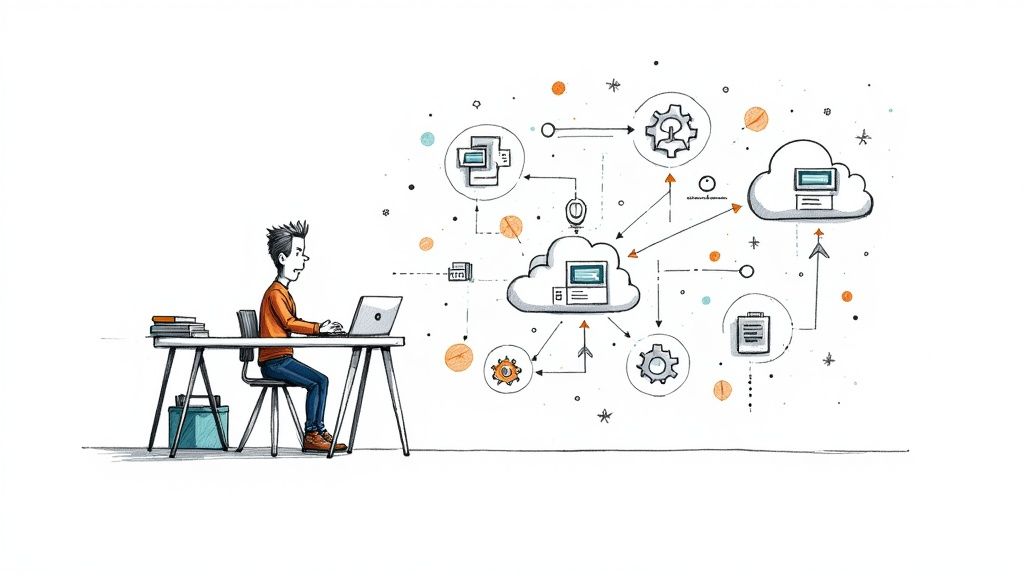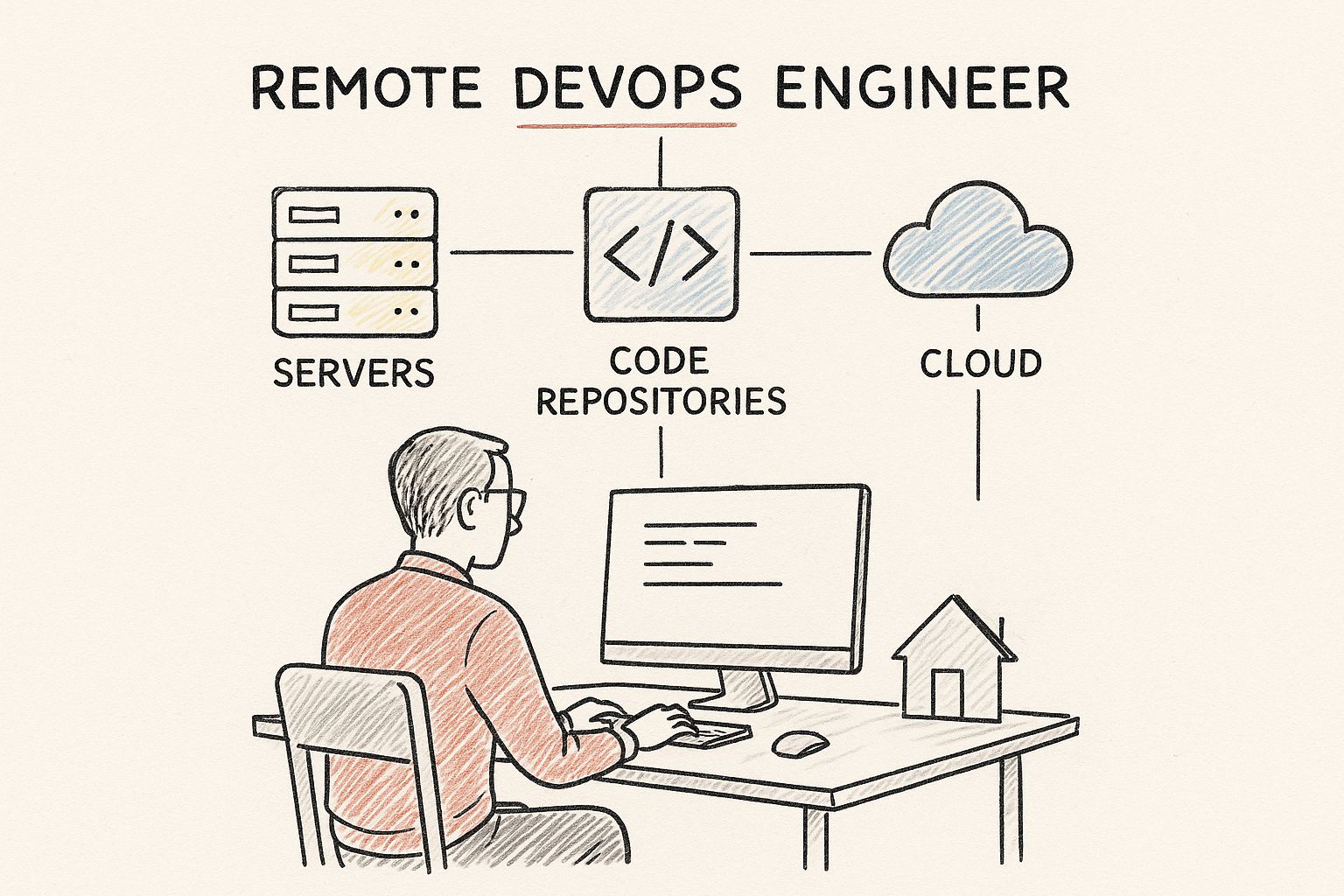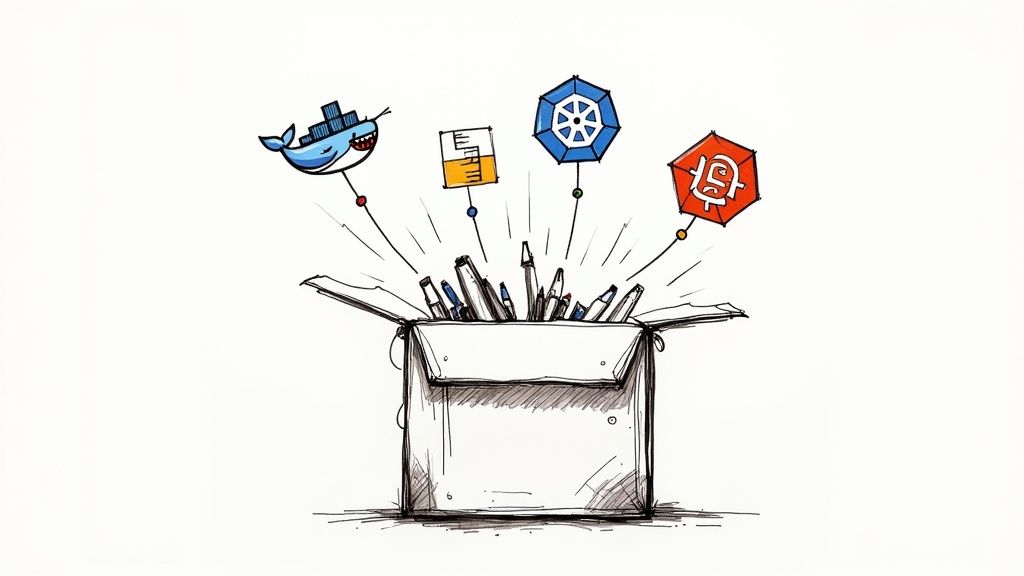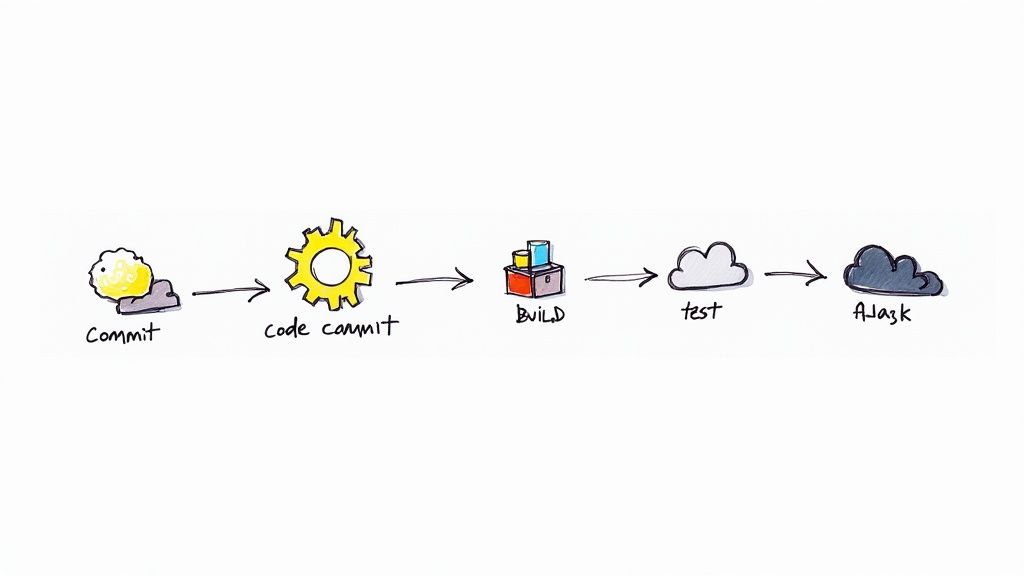Become a Remote DevOps Engineer | A Technical Career Guide
Learn how to succeed as a remote DevOps engineer with essential skills, tools, and strategies. Start your remote DevOps engineer career today!

A remote DevOps engineer is a specialist who bridges the gap between software development (Dev) and IT operations (Ops) from a distributed location. Their primary mandate is to automate and streamline the entire software delivery lifecycle—from code commit to production deployment and monitoring. This is achieved by implementing a culture of collaboration and leveraging a specific stack of tools to build, test, and release software with greater speed, reliability, and security.
Why Remote DevOps Engineers Are in Such High Demand
In the current technology landscape, velocity and resilience are non-negotiable for business survival. Companies must deploy updates, patch vulnerabilities, and launch features at an unprecedented pace. The remote DevOps engineer is the architect of the automated systems that make this possible.
Traditionally, software development was a siloed, sequential process. Developers wrote code, threw it "over the wall" to QA, who then passed it to operations for deployment. This created bottlenecks, miscommunication, and lengthy release cycles. A DevOps engineer dismantles these walls by building a shared, automated pipeline that unifies development and operations. When this engineer can architect and manage this entire process from anywhere, they become an invaluable asset for a modern, distributed company.
The Business Case for DevOps
The value of a remote DevOps engineer is not purely technical; it directly impacts key business metrics by solving critical operational challenges:
- Accelerated Time-to-Market: By implementing a fully automated CI/CD pipeline, software moves from a developer's commit to production in minutes, not weeks.
- Enhanced Scalability and Resilience: They design cloud-native infrastructure using principles like Infrastructure as Code (IaC) and container orchestration, allowing systems to auto-scale during traffic spikes and self-heal from component failures.
- Hardened Security Posture (DevSecOps): By integrating security scanning and policy enforcement directly into the CI/CD pipeline, they shift security "left," creating applications that are secure by design, not by audit.
The Surge in Remote-First Roles
The demand for DevOps expertise has exploded, particularly for remote positions. IT hiring has fundamentally shifted towards cloud-native, location-independent talent. A recent report found that 29% of IT teams globally have recently hired a DevOps engineer, making it the single most recruited role in tech.
This boom is massively fueled by the move to hybrid and remote work, with nearly one-third of all DevOps professionals now working primarily from home. You can dig into the full breakdown of these trends and see how tools like Docker and Kubernetes are shaping the role on Brokee.io.
This isn't just a fleeting trend. It’s a fundamental change in how great software gets built and maintained. The remote DevOps engineer is the glue holding distributed development and operations teams together in this new reality.
Ultimately, the intense demand for remote DevOps engineers is rooted in their proven ability to deliver speed, stability, and scale—the three technical pillars that support all modern digital enterprises.
Mastering the Remote DevOps Technical Stack
A top-tier remote DevOps engineer is the architect and mechanic of the digital superhighways our software runs on. This requires a deep, hands-on command of the specific tools that drive automation, scalability, and observability, especially when managing distributed systems.
To excel, you must prove you can design, build, and manage a cloud-native infrastructure from the command line. It's less about a long list of buzzwords and more about demonstrating how specific tools integrate to form a cohesive, automated delivery pipeline.
The infographic below lays out the core domains of expertise. Think of it as a map showing how different toolsets connect to form a cohesive technical stack.

As you can see, it’s all about integration. Knowing how these pieces fit is what separates a good engineer from a great one.
Infrastructure as Code (IaC)
IaC is the practice of managing and provisioning infrastructure through machine-readable definition files, rather than physical hardware configuration or interactive configuration tools. It is the bedrock of modern DevOps, enabling repeatable, auditable, and version-controlled environments—critical for remote teams.
- Terraform: The de-facto standard for cloud-agnostic provisioning. You define your desired state in HashiCorp Configuration Language (HCL), and Terraform executes a plan to create, update, or destroy resources to match that state.
- Ansible: An agentless configuration management tool used for post-provisioning tasks. Once Terraform creates a VM, Ansible can connect via SSH to install packages, apply security policies, and configure services using simple YAML-based playbooks.
Continuous Integration and Delivery (CI/CD)
A CI/CD pipeline is the automated workflow that moves code from a developer's commit to a production environment. For a remote team, this pipeline is the central nervous system for collaboration, enforcing quality gates and providing a transparent deployment process.
A well-architected CI/CD pipeline is the ultimate force multiplier for a remote DevOps engineer. It codifies best practices, slashes manual effort, and provides a transparent, automated path from a developer's machine to the end user.
Tools like GitLab CI, GitHub Actions, and Jenkins power these pipelines. A skilled remote engineer must be fluent in defining multi-stage YAML pipelines, managing build artifacts in object storage, and integrating static analysis security testing (SAST) tools directly into the workflow.
Containers and Orchestration
Containers provide OS-level virtualization by packaging an application and its dependencies into a single, portable unit. This solves the "it works on my machine" problem by ensuring consistency across all environments.
- Docker: The primary tool for building and running containers. A remote DevOps engineer uses a
Dockerfileto define the image layers, creating a lightweight, immutable artifact that can be deployed anywhere. - Kubernetes: The leading container orchestration platform. When deploying at scale, Kubernetes automates the deployment, scaling, networking, and self-healing of containerized applications. Proficiency in Kubernetes, including concepts like Deployments, Services, and Ingress, is a core requirement for nearly every senior remote DevOps role.
Observability and Monitoring
You can't fix what you can't see. Observability is the practice of instrumenting systems to collect metrics, logs, and traces, providing deep insight into their internal state. This is critical in a remote setting for rapid incident response.
- Prometheus: An open-source monitoring and alerting toolkit. It scrapes time-series metrics from configured endpoints, stores them efficiently, and allows for powerful queries using its native query language, PromQL.
- Grafana: The visualization layer for your metrics. Grafana connects to data sources like Prometheus to build interactive dashboards for monitoring system health, diagnosing performance bottlenecks, and spotting anomalous trends.
To bring this all together, here’s a look at how some of these popular tools stack up against each other in a typical remote DevOps toolchain.
Essential Remote DevOps Toolchain Comparison
This table helps illustrate the different options available across the key DevOps categories. While some tools are clear leaders, knowing the alternatives can be incredibly valuable depending on the project's specific needs.
| Category | Primary Tool (Example) | Alternative Tool (Example) | Key Use Case |
|---|---|---|---|
| Infrastructure as Code | Terraform | Pulumi, AWS CDK | Defining and provisioning cloud infrastructure using code. |
| Configuration Management | Ansible | Chef, Puppet | Automating software installation and system configuration. |
| CI/CD | GitLab CI / GitHub Actions | Jenkins, CircleCI | Automating the build, test, and deployment of applications. |
| Containerization | Docker | Podman | Packaging applications and their dependencies into portable units. |
| Container Orchestration | Kubernetes | Docker Swarm, Nomad | Managing and scaling containerized applications automatically. |
| Monitoring & Metrics | Prometheus | Datadog, InfluxDB | Collecting time-series data and metrics from systems. |
| Visualization & Logging | Grafana | Kibana (ELK Stack) | Creating dashboards and analyzing logs for observability. |
Choosing the "right" tool often depends on your team's existing skills, your cloud provider, and the specific problems you're trying to solve. But mastering the primary tools in each category will make you a highly effective and sought-after remote DevOps engineer.
The Financial Case for a Remote DevOps Career

Choosing a career is a major financial decision. For a remote DevOps engineer, the compensation data tells a compelling story. This role is a financial powerhouse, driven by intense demand for a highly specific and valuable skill set.
The premium salary exists because DevOps engineers directly influence development velocity and operational stability—the two pillars supporting a modern software business. Companies willingly pay top dollar for an expert who can optimize both.
Understanding Your Market Value
To maximize your earning potential, you must understand your market worth. Data consistently shows that experienced DevOps engineers in the U.S. command average base salaries between $160,000 to $170,000 annually. For principal engineers or those with specialized Site Reliability Engineering (SRE) skills, total compensation can climb as high as $297,000.
The best part? This isn't just for people living in expensive tech hubs. Data shows that 51% of all DevOps positions on the market are remote. This proves that you don't need to be tied to a specific office to command a top-tier salary.
This is a global phenomenon. In burgeoning tech markets like India, a senior DevOps role can command salaries from ₹12 to ₹18 lakh annually. This demand is fueled by a very real 37% skills gap in IT leadership—a gap that companies are scrambling to fill with qualified remote talent.
Before entering negotiations, you must conduct thorough market salary research. Walking into a negotiation armed with real data is the only way to ensure you're compensated fairly.
Future Growth and Long-Term Stability
Beyond the immediate financial benefits, the long-term career trajectory for a remote DevOps engineer is exceptionally secure. The core competencies—cloud architecture, CI/CD automation, and container orchestration—are foundational to the future of technology.
As more enterprises migrate to the cloud and embrace automation, the demand for these skills will only accelerate. This is a field defined by continuous learning, which translates directly into career and financial growth. As you master new technologies and architectures, your value to any organization increases exponentially. It’s a clear path for advancement. If you're looking to see what's out there right now, check out our guide on finding the best remote DevOps engineer jobs.
Think of it this way: this isn't just a job. It's a strategic investment in a skill set that's essentially future-proof.
Communicating Effectively in a Distributed Team
Technical expertise gets you the interview; communication skills get you the job and make you successful as a remote DevOps engineer. In a distributed team, you cannot rely on informal, high-context communication like walking over to a colleague's desk.
Success hinges on mastering asynchronous communication and building trust through deliberate, high-fidelity interactions. Every piece of written communication—a pull request description, a Jira ticket update, a Slack message—must be clear, concise, and context-rich. A vague bug report or a pull request with a one-line description can stall a project for hours. In a remote environment, your words are your most critical tool.
Mastering Asynchronous Collaboration
For most distributed teams, asynchronous work is the default operating mode. This requires a fundamental shift from real-time communication to creating durable, high-quality artifacts that empower your teammates to work independently. The objective is to provide everything another engineer needs to unblock themselves without needing a synchronous meeting with you.
Key actionable practices include:
- Writing Production-Ready Documentation: Your infrastructure diagrams, runbooks, and incident post-mortems must be so clear that a new hire can understand and execute them without assistance. This is a core job function, not an afterthought.
- Crafting Atomic, High-Context Pull Requests (PRs): A good PR is a self-contained story. It should link to the corresponding ticket, summarize the problem it solves (
the why), detail the technical implementation (the how), and provide clear testing instructions. - Using Communication Tools with Intent: Tools like Slack and Jira are essential. A well-structured Jira ticket with clear acceptance criteria is infinitely more valuable than a fragmented conversation in a noisy Slack channel. Use threads religiously to keep conversations organized.
The foundation of any successful distributed team is trust. And that trust is built brick-by-brick through clear, consistent, and proactive communication. When you truly own your work and are transparent about your progress, you become a pillar your team can rely on.
Proactive Ownership and Building Trust
In an office, physical presence creates visibility. Remotely, demonstrated ownership is your visibility. This isn't about being "online" constantly; it's about being proactive and transparent.
Anticipate and flag potential issues. Communicate blockers as soon as they arise, along with potential solutions. Share your learnings in public channels. This is how you build the social capital and deep-seated trust that high-performing remote teams run on. Given the distributed nature of remote work, mastering effective communication also involves understanding how to improve team collaboration.
At the end of the day, the best remote DevOps engineers know their job extends far beyond the command line. They are expert communicators who understand that the entire DevOps methodology is about demolishing silos between teams—a goal that demands stellar communication, especially when those teams are thousands of miles apart.
Building Your Hands-On DevOps Portfolio

Theoretical knowledge is insufficient for landing a top-tier remote DevOps role. A portfolio of projects demonstrating hands-on expertise is what truly distinguishes a candidate. Hiring managers need tangible evidence that you can design, build, automate, and manage cloud infrastructure effectively. This is where you translate concepts into a compelling, hirable narrative.
Your primary goal is to build a project that mirrors a real-world DevOps workflow, demonstrating core competencies in Infrastructure as Code (IaC), CI/CD, and containerization. A single, well-executed project is your proof of practical skill.
Setting Up Your Personal Cloud Lab
First, you need a development environment. Your personal cloud lab is where you will build and test. Fortunately, major cloud providers like AWS, GCP, and Azure offer generous free tiers sufficient for building a professional-grade portfolio project at no cost.
Sign up for a free-tier account with your preferred provider. This process itself is valuable experience, as it familiarizes you with the provider's console, identity and access management (IAM), and billing alerts—daily concerns for a DevOps professional.
The Core Project: Deploying a Containerized Application
Here is a blueprint for a portfolio project that will demonstrate the most in-demand skills for a remote DevOps engineer: deploying a simple, containerized web application with a fully automated pipeline.
Here’s a step-by-step technical breakdown:
-
Containerize the App: Begin with a basic web application (e.g., Python Flask or Node.js Express). Create a
Dockerfilethat builds a production-ready, multi-stage image to keep it small and secure. This demonstrates your understanding of containerization best practices. -
Define Infrastructure with Terraform: Write Terraform code (
.tffiles) to provision the necessary cloud infrastructure. This should include a virtual private cloud (VPC) with public/private subnets, security groups, and a managed Kubernetes cluster (e.g., AWS EKS, GCP GKE, Azure AKS). A critical best practice is to configure a remote backend (e.g., an S3 bucket with state locking via DynamoDB) for your Terraform state. This proves you understand how to manage infrastructure state collaboratively and safely. -
Build a CI/CD Pipeline: Use GitHub Actions to create a workflow (
.github/workflows/main.yml) that automates the entire process. The pipeline should trigger on a push to themainbranch and execute the following stages:- Lint & Test: Run static analysis and unit tests on the application code.
- Build & Push: Build the Docker image and push it to a container registry (e.g., Docker Hub, Amazon ECR).
- Deploy: Use
kubectlor a GitOps tool like Argo CD to apply the Kubernetes manifests and deploy the new image version to your cluster.
By building this, you’re doing more than just showing you know a few tools. You are proving you can weave them into a seamless, automated system that takes code from a developer's machine to production. That is the absolute essence of DevOps.
To execute this project, strong scripting skills are essential. It's highly recommended to work through some hands-on shell scripting and DevOps projects to solidify your foundation.
Documenting Your Project on GitHub
Your GitHub repository is your portfolio. Treat it as a professional product. A well-documented repository is a strong signal to hiring managers.
Your README.md file must be a comprehensive guide and should include:
- A clear, high-level overview of the project's purpose and architecture.
- An architecture diagram (created with a tool like diagrams.net) that visually explains the flow of data and services.
- Explicit, step-by-step instructions on how to clone, configure, and deploy the project.
- A detailed breakdown of the CI/CD pipeline, explaining the purpose of each job and step.
This level of documentation demonstrates the strong communication and asynchronous collaboration skills required of any successful remote DevOps engineer.
Finding and Winning a Top Remote DevOps Role
Landing a top-tier remote DevOps engineer role requires more than a standard resume. You are not just proving technical competence; you are proving you can be a high-impact engineer in a distributed environment. The key is to demonstrate tangible results and a deep understanding of business-centric problem-solving.
Your resume must be impact-oriented. Avoid generic statements like "managed CI/CD pipelines." Instead, quantify your achievements. Reframe every bullet point as a result. For example: "Reduced deployment times by 40% by re-architecting GitLab CI pipelines, leading to a 15% increase in feature release velocity." This demonstrates that you solve business problems, not just use tools.
Decoding Job Descriptions and Acing Interviews
To gain a competitive edge, you must learn to interpret job descriptions. A company isn't just looking for a technologist; they are seeking a problem-solver who understands the why behind technical decisions.
When a job description lists "strong experience with Kubernetes," they are implicitly asking:
- Can you design a resilient, self-healing system that can withstand node failures?
- Do you have a strategy for managing stateful applications and secrets within the cluster?
- Can you implement a secure GitOps workflow that provides an auditable trail of all changes to the cluster state?
Your interview strategy must address these underlying questions. Be prepared for system design interviews and hands-on technical challenges. When asked about your choice of tools, always justify your decision by linking it back to business goals like reliability, cost optimization, or security posture.
The global DevOps market is exploding, projected to hit around $81.1 billion USD by 2033. This massive growth is driven by one thing: the shift to remote work. A deep dive into over 25,000 job postings revealed that a staggering 33% of all DevOps positions are now fully remote. That’s not a trend; it's the new standard. To see the full data, check out the Kubernetes and DevOps job market report.
Where to Find Quality Remote Roles
While general job boards can be a starting point, the highest quality roles are often found on specialized platforms focused on remote work and technology.
Better still, engage with the community. Become an active participant in DevOps-focused LinkedIn groups, Subreddits, or niche Slack/Discord communities. Many of the best opportunities are filled through networking and referrals before they are ever publicly posted.
Winning a premier remote role is a combination of deep technical expertise and exceptional communication. Show what you have built, articulate its impact, and demonstrate that you understand the business's underlying needs.
If you want a curated list of high-quality openings, you can check out our regularly updated board of DevOps work opportunities.
Got a few more questions? Let's dig into some of the common things people ask about what it's really like to be a remote DevOps engineer.
What Is the Biggest Challenge for a Remote DevOps Engineer?
The single greatest technical challenge is combating infrastructure drift in a distributed team.
Infrastructure drift occurs when the actual state of your cloud environment deviates from the state defined in your version-controlled code (e.g., your Terraform files). This is often caused by manual, "out-of-band" changes made directly in the cloud console, typically during an emergency incident response, which are then not back-ported to the code.
These untracked changes accumulate over time, creating a "snowflake" environment that is impossible to reproduce, leading to failed deployments, unpredictable behavior, and security vulnerabilities. A great remote DevOps engineer mitigates this by enforcing strict GitOps principles and implementing automated drift detection tools that regularly compare the live environment against the desired state in Git.
How Does DevSecOps Apply in a Remote Context?
DevSecOps—integrating security practices into every phase of the software lifecycle—is even more critical in a remote setting. A distributed workforce inherently expands the attack surface, making automated security controls non-negotiable.
For a remote team, this means implementing:
- Automated Security Scanning in CI/CD: Integrate Static Application Security Testing (SAST), Dynamic Application Security Testing (DAST), and software composition analysis (SCA) tools directly into the pipeline. This provides immediate feedback to developers and prevents vulnerabilities from reaching production.
- Centralized Secret Management: Enforce the use of a secret management system like HashiCorp Vault or AWS Secrets Manager. Credentials, API keys, and certificates must never be hard-coded in Git repositories.
- Immutable Infrastructure: Treat infrastructure components as ephemeral. Instead of patching a live server, a new, patched image is built, and the old server is destroyed and replaced. This eliminates configuration drift and ensures a consistent, secure baseline.
What Does a Typical Day Look Like?
There is no "typical" day, but the role revolves around a set of core activities:
- Asynchronous Communication: A significant portion of the day is spent writing: detailed pull request descriptions, clear updates in Jira tickets, and comprehensive documentation in a wiki (like Confluence).
- Pipeline Management: Monitoring CI/CD pipelines, debugging failed builds, and optimizing stages for speed and reliability.
- Infrastructure as Code Development: Writing or modifying IaC files using tools like Terraform or Ansible to provision new environments or update existing infrastructure.
- Incident Response: Responding to alerts from monitoring systems like Prometheus and Grafana, triaging issues, and collaborating with developers on a video call or Slack huddle to troubleshoot production problems.
It's a continuous blend of proactive architectural work and reactive problem-solving, all orchestrated through clear, precise, written communication.
Ready to scale your operations with elite talent? OpsMoon connects you with the top 0.7% of remote DevOps engineers. Start with a free work planning session and let us build your high-performance team. Get started with OpsMoon today.
